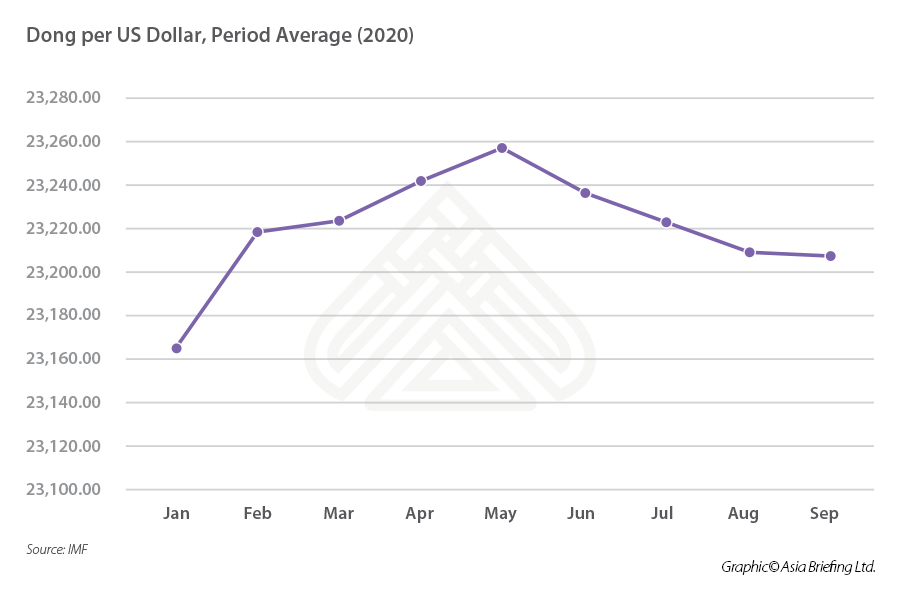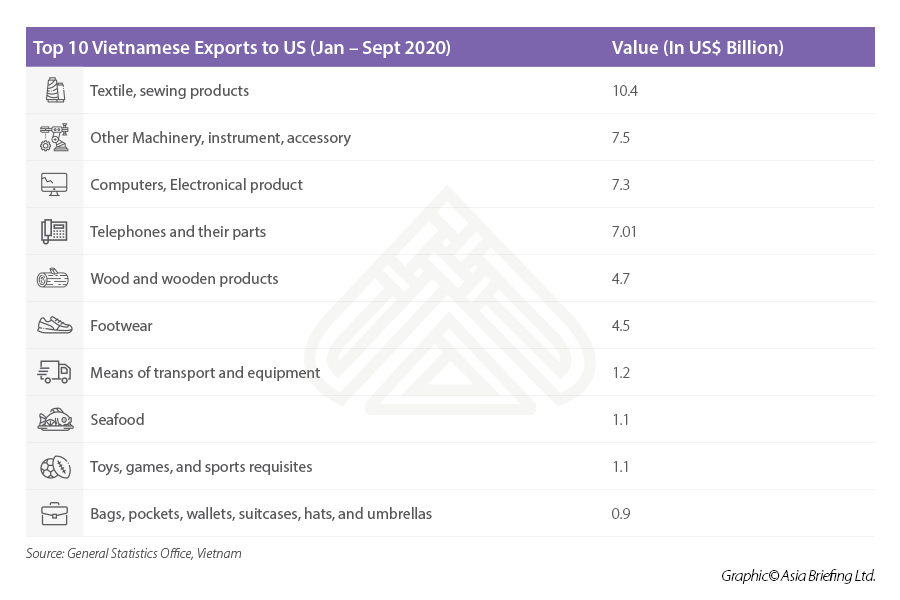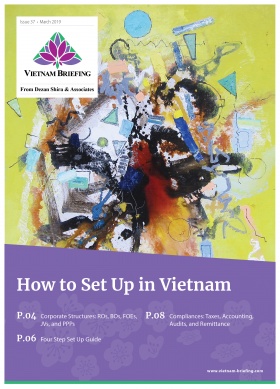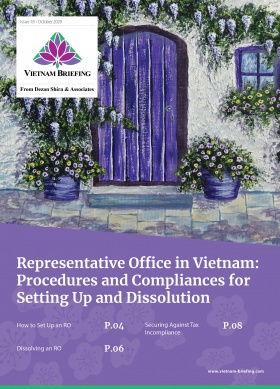What the US’ Currency Manipulator Label Means for Vietnam
- Vietnam, along with Switzerland were labeled as currency manipulators by the US Department of Treasury in its annual report on stopping countries from gaining unfair trade advantages.
- Currency manipulation is a label associated with countries who consistently intervene in currency markets in order to artificially devalue their currencies against major currencies such as the US dollar. Manipulators could be subject to countervailing duties.
- The process to impose duties on Vietnam is riddled with legal challenges and is time-consuming. It is likely that the outcome will depend on the trade policy decisions of the incoming Biden administration.
On December 16, 2020, the US Department of Treasury labeled Vietnam as a currency manipulator, a move that could potentially lead to the US finding sufficient cause to introduce countervailing duties.
Vietnamese officials claim that the label is misleading and the country’s exchange rate policy is not targeted at ‘creating an unfair competitive advantage’ for Vietnamese exports. Vietnam Briefing looks into the currency manipulator label and discusses its likely impact on the Vietnamese economy.
What is currency manipulation?
Vietnam’s low exchange rate means that Vietnamese companies that sell goods to the US earned more dong from the dollars they received from US customers, while American businesses would pay more to exchange the dong.
A country’s exchange rate is a key determinant of export competitiveness. Lower value vis-à-vis other major currencies creates cost competitiveness for exporting firms. However, global currency markets are subject to both market forces and speculative pressure.
In order to protect this cost competitiveness in international trade, a country’s central bank may choose to resist currency appreciation through purchases of foreign assets and increasing foreign reserves. For instance, the US Trade Representative claims that in 2020, the Vietnamese Dong was 8 percent lower than the market value.
The chart below shows the movement of the exchange rate leading up to September 2020.
There are costs and benefits of devalued currencies in international trade. The main beneficiaries of such interventions are sectors of the economy that are sensitive to external demand. It is for this reason that such interventions are most common in export-driven economies and oil exporters.
Most notably, numerous East Asian economies such as China, Japan, Korea, Thailand, and Malaysia have often increased foreign reserves by significant amounts.
These interventions result in bilateral trade surpluses with major trading partners. In the case of Vietnam, data from the US Treasury shows that in 2020 the bilateral goods trade surplus with the US was US$58 billion, up from US$47 billion in 2019. These trade surpluses are associated with the decline of competing firms in the US, which is reflected in job losses.
Estimates from the US Commerce Department state that reducing the US trade deficit by US$200 billion could create 1 million jobs. For this reason, exchange rate interventions that artificially devalue currencies are not viewed favorably by major importers such as the US.
However, exchange rate intervention by itself does not constitute currency manipulation. Many central banks have mandates to ensure exchange rate stability and intervene in currency markets to minimize currency volatility and control speculative pressure.
This intervention is interpreted as manipulation under US legislation when three conditions are met: the country accumulates
- ‘significant’ bilateral trade surplus;
- ‘material’ current account surplus; and
- engages in ‘persistent’ unilateral intervention in the currency market.
In 2020, Vietnam met all three conditions as per the treasury report.
How is the US likely to proceed: 2 possible scenarios
Scenario – I: the US imposes countervailing duties
The treasury intends to engage with policymakers in Vietnam and recommend a set of policy options primarily aimed at minimizing the bilateral trade deficit. If engagement does not lead to favorable outcomes, the US could impose countervailing duties on Vietnam.
The final decision is expected to be released by March 2021. However, before imposing duties, the US International Trade Commission must demonstrate that there was ‘material injury’ to US firms.
In addition, the Trump administration has also invoked Section 301 of the US Trade Act (1974) to claim that in 2019 the Vietnamese central bank purchased US$22 billion in dollars in order to devalue the dong. Section 301 investigations can take months but once concluded, the imposition of duties does not require any demonstration of ‘material injury’.
The claims are likely to face legal challenges since World Trade Organization (WTO) rules do not define exchange rate changes as export subsidies and the imposition of countervailing duties could be interpreted as a violation of WTO rules. Therefore, if and when these duties are applied, Vietnamese officials could pursue a WTO case against the US.
Scenario – II: US pursues bilateral engagement and WTO reform
US President-elect Joe Biden’s trade policy preferences reflect a dual interest in countering China’s influence in global trade and pursuing multilateral trade negotiations at the WTO. During the presidential campaign, Joe Biden had pledged to protect American jobs and signaled a need to renew the US government’s stance on the WTO and discuss a reform agenda.
In addition, as Vice President, Biden had negotiated the Trans-Pacific Partnership (TPP) trade deal, arguing in favor of multilateral trade. Under a Biden presidency, the US re-joining trade deals in the Asia Pacific remains subject to domestic political constraints. For instance, there is a strong bipartisan consensus in the US congress that some trade deals have more costs than benefits for the US economy.
Therefore, one possible outcome is that the Biden administration continues engagement with Vietnam and insists that Vietnamese authorities ensure fair trade practices.
After the US labeled Vietnam as a currency manipulator, in a recent phone conversation with President Trump, Vietnam’s Prime Minister Nguyen Xuan Phuc signaled a willingness to increase Vietnamese purchases of American airplanes, liquefied natural gas (LNG), and agricultural products. It is likely that the US will push for similar increases in Vietnamese imports in order to reduce the bilateral deficit.
As a parallel tool, the US could push for WTO reform, which includes defining currency manipulation as a form of export subsidy. This could then give the US legal grounds to impose duties against a broad range of economies who have trade surpluses with the US and those who intervene in currency markets.
The impact on Vietnam
For Vietnam, cooperating with the US officials appears to be strategically vital. In June 2019, Vietnam ordered customs officials to carefully monitor certificates of origin from Vietnam in a bid to appease US officials.
Since 2016, the US-China trade war has catalyzed the movement of manufacturing supply chains into Vietnam. Between 2016 and 2018, quarterly exports from Vietnam to the US increased by US$6.4 billion. Analysts from Nomura estimated that in 2019, Vietnam’s gain from the trade war was equivalent to nearly 8 percent of GDP.
The US is Vietnam’s largest export market. In 2020, the US bought US$37.9 billion of Vietnamese exports, a growth of 15 percent compared to 2019. The table below shows that in 2020, major exports to the US included US$10.4 billion in textile products, US$7.5 in machinery, and US$7.3 billion of computer and electronic products among others. Other notable exports include cashew, plastics, iron and steel products, precious stones, and processed vegetables.
An increasing number of American firms are also targeting Vietnam as an alternative manufacturing destination. US firms such as Wanek Furniture, Ashley Home, Google, Universal Alloy Corporation (UAC), and Intel are among those who have announced plans to expand their businesses in Vietnam.
The US is therefore a crucial economic partner for Vietnam and the imposition of duties would negatively impact export earnings in addition to hurting investor sentiment. It is therefore likely that Vietnamese officials will focus on engagement with the US to prevent this outcome.
To this effect, Vietnam and US officials have already scheduled talks to discuss trade issues with Vietnam saying it was “extremely important for the two sides to maintain talks at the moment.”
The US-Vietnam relationship remains strong. The US Chamber of Commerce also argued against the US Department of Treasury claims, that Vietnam did not meet the three-part test of evaluating whether a country is engaging in currency manipulation.
All these factors bode well for Vietnam-US trade. Nevertheless, it’s likely a wait and watch scenario as the Biden administration takes over come January 2021.
About Us
Vietnam Briefing is produced by Dezan Shira & Associates. The firm assists foreign investors throughout Asia from offices across the world, including in Hanoi and Ho Chi Minh City. Readers may write to vietnam@dezshira.com for more support on doing business in Vietnam.
- Previous Article Situazione corrente della filiera produttiva in Vietnam
- Next Article The UK’s Trade Deal with Vietnam Builds on Hanoi’s Accord with the EU

































